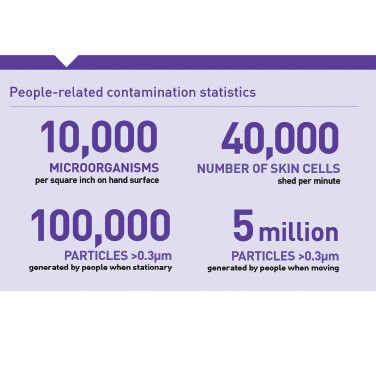How to Guard Against Cleanroom Contamination
By Anita McLean, Scientific Category Manager
Kimberly-Clark Professional
Where purity is paramount, contamination is bad for business — especially for labs, cleanrooms, and pharmaceutical manufacturing.
To protect your processes from contamination, look at the main source. People are the greatest contributor and account for 46 percent of all particle contamination.1
Skin flakes, oils, perspiration, and hair can all contribute to cleanroom contamination. And even the most carefully manicured person generates a shroud of particles every day.2
Did You Know?
- People shed 1 billion skin cells per day3
- Five million particles larger than 0.3 microns are generated when people move4
- One milliliter of saliva contains 100 million microbes5
To help increase the visibility of these invisible contaminants, Kimberly-Clark Professional launched the Dressed For Success program.
How It Works
Dressed For Success uses sterile single-use apparel and gloves to reduce contamination from both viable particles (bacteria and yeast) and non-viable particles (hair, dead skin cells, and dandruff).
Sterile Single-Use Garments
Kimtech apparel and other sterile single-use garments are designed to reduce contamination risk and offer significantly higher bacterial filtration efficiency (BFE) ratings than laundered reusable apparel. These nonwoven garments also provide a strong barrier against particles and liquids, and they’re guaranteed to be sterile every time.
How do they compare to reusables? Laundered garments can degrade after multiple laundry and sterilization cycles. Testing conducted by Kimberly-Clark Professional revealed BFE can decline more than 25 percent after an average of five washes.6 That’s equivalent to one out of four workers not wearing sterile garments at all — a real, yet invisible, contamination risk.
Other Benefits
- Apparel features that lower the risk of contamination during the donning process
- A sterility assurance level of 10-6
- Breathable, cloth-like comfort
Remember, not all garments perform equally when it comes to restricting particles. That’s why it’s essential to choose a garment that controls contamination and gives workers the assurance to do their best work.
- Gloves
Have you thought about how your choice of gloves could be putting your research at risk? Products as simple as exam gloves can compromise the quality and integrity of your work in several ways: - Contamination
The tearing of low-quality gloves can lead to process contamination, ruining days, weeks, or even months of painstaking work. Compromised gloves also increase the risk of contamination and injury to the user. - Excessive Consumption and Cost
A low-quality glove may be compromised too quickly, resulting in the use of multiple pairs during even short periods of time. - Landfill Waste
All of these used gloves must go somewhere. Nearly a third of a university’s solid waste comes from labs and research buildings, and disposable gloves compose 22 percent of that waste.
While they may look alike, not all gloves can protect the integrity of your science like Kimberly-Clark Purple Nitrile Exam Gloves — the glove of choice since 1999. Purple Nitrile Exam Gloves are up to 50 percent stronger than typical exam gloves7 and deliver proven chemical splash and biological protection. They are tested against the highest safety and quality standards in the research industry8 and provide the tactile sensitivity and grip of much thinner gloves.9
Environmental Benefits
In addition to these benefits, Kimtech apparel, gloves, and safety eyewear are recyclable through The RightCycle Program. This is the first large-scale recycling initiative for non-hazardous lab, cleanroom, and industrial waste. The program diverts these products from your waste stream and turns them into new consumer goods. That’s good for the planet and good for business.
Visit fishersci.com/kimberlyclark to learn more about Kimtech products, Dressed For Success, and The RightCycle Program.
Anita McLean is a Category Manager with the Kimberly-Clark Professional Global Scientific Business.
- “The Contamination Risks Posed by Laundered Cleanroom Apparel,” Kimberly-Clark Professional white paper, 2014
- "Gowning Procedures." Gowning Procedure -. N.p., n.d. Web. 04 Oct. 2018. https://cleanroom.gatech.edu/articles/87
- Sandle, B. (2014). “People in Cleanrooms: Understanding and Monitoring the Personnel Factor” IVT Network
- Larkin, D. (2009) “The Human Element,” Controlled Environments
- RDH Magazine, 2015
- Kimberly-Clark Test Study
- ASTM D412
- ASTM 6319, ASTM D 6978-05, ISO-10993
- Sensory Panel, n=12

Content provided by:
Visit fishersci.com/kimberlyclark for more information.
Read More from Lab Reporter Issue 2, 2019
- Adaptive Fabric Responds to Changes in Body Temperature
- Brain Metabolism Study Reveals Age Differences Between Sexes
- Chemical Accelerators: The Glove-Related Allergen of the 21st Century
- Ductless Fume Hood Safety
- How to Choose the Right Desiccator
- How to Guard Against Cleanroom Contamination
- Microplastics: Investigating Risk and Understanding Evidence
- Protecting n-Butyllithium from Air and Moisture
- Reduce Strain with Ergonomically Certified Gloves
- Safety Compliance: A Team Effort at Texas A&M
- Save Incubator Space with Round Multilayer Devices
- Second HIV Patient in Remission After Stem Cell Transplant
- Solvent Exposure Can Lead to Hearing Loss
- TCI: Innovating to Improve Lab Safety



